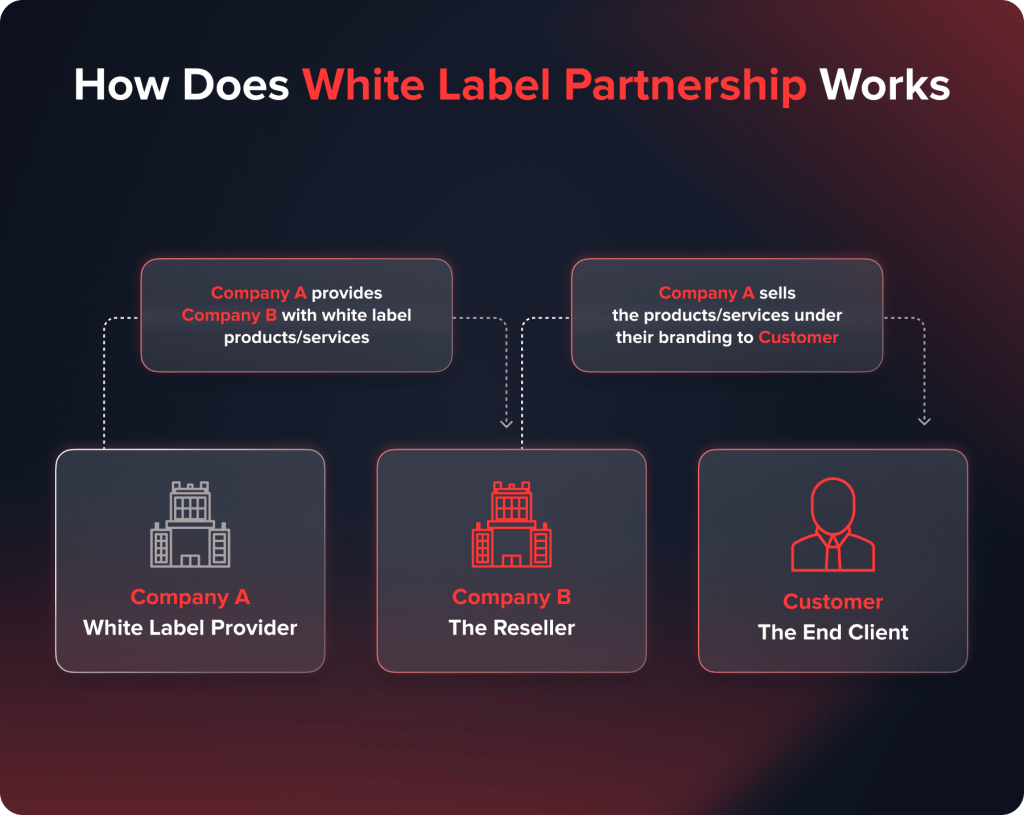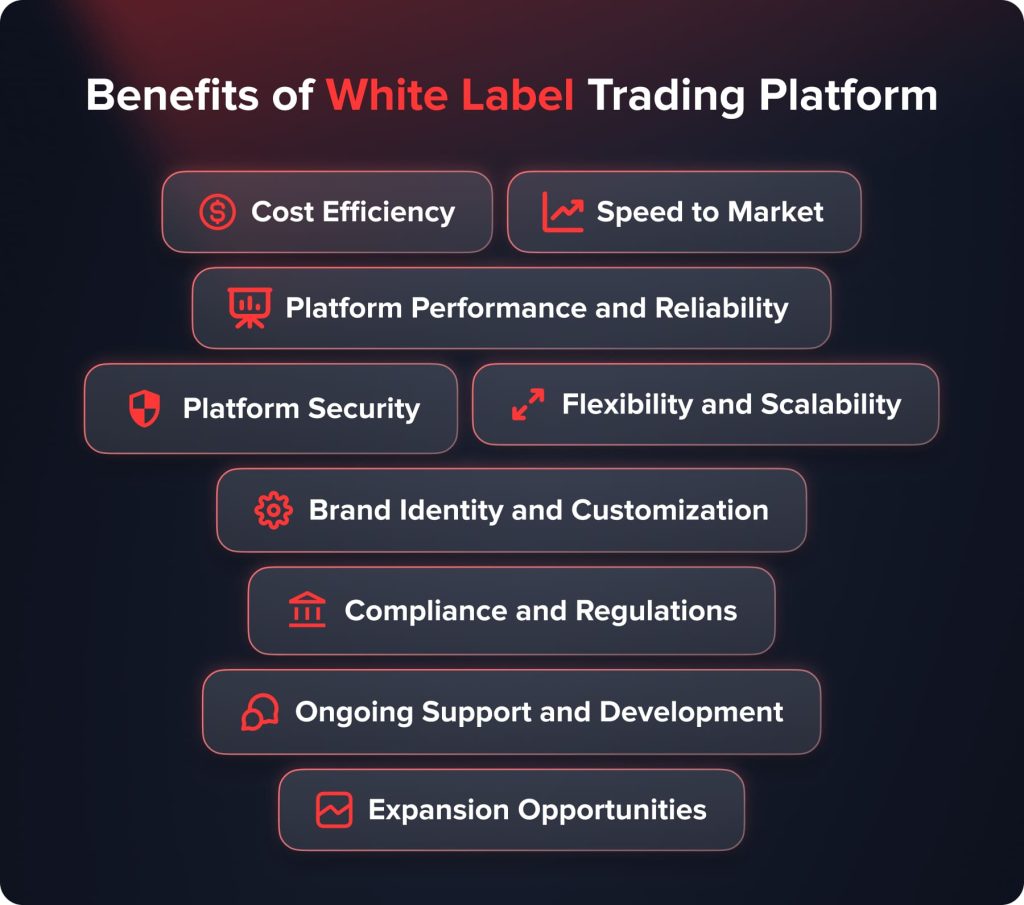
แพลตฟอร์มการซื้อขาย White Label คืออะไรและทำงานอย่างไร?
เนื้อหา
ในโลกการเงินที่เปลี่ยนแปลงอย่างรวดเร็ว ทุกคนต่างมองหาวิธีแก้ปัญหาที่ปรับแต่งได้และมีคุณภาพสำหรับการเริ่มต้นธุรกิจนายหน้าเป็นของตัวเอง การใช้โซลูชันแบรนด์ขาว (white label) ได้กลายเป็นทางเลือกที่ได้รับความนิยมอย่างมากสำหรับเจ้าของธุรกิจที่มีแนวโน้มหลายคน เพราะช่วยให้พวกเขาสามารถเข้าถึงตลาดได้อย่างรวดเร็วโดยไม่ต้องเสียค่าใช้จ่ายที่สูงลิ่วซึ่งเกี่ยวข้องกับการพัฒนาระบบที่เป็นกรรมสิทธิ์ สำหรับผู้ที่ไม่คุ้นเคยกับมัน ระบบ white label คือผลิตภัณฑ์ที่พัฒนาเสร็จสมบูรณ์และพร้อมใช้งานโดยบริษัทภายนอก ความสวยงามของการจัดเรียงนี้คือคุณสามารถสร้างแบรนด์ผลิตภัณฑ์เป็นของคุณเอง บทความนี้จะเจาะลึกเข้าไปในแนวคิดของแบรนด์ขาวและเน้นจุดเด่นของมัน

คำอธิบายเกี่ยวกับ White Label
เจ้าของธุรกิจที่ต้องการเข้าตลาดการเงินกำลังใช้ประโยชน์จาก แพลตฟอร์มการเทรดแบบ White Label (WL) มากกว่าที่เคยเป็นมา แพลตฟอร์มการเทรด WL คือโซลูชันซอฟต์แวร์ที่ครบถ้วนและครอบคลุมที่สร้างขึ้นโดยเฉพาะสำหรับตลาดการเงิน แพลตฟอร์มเหล่านี้ถูกออกแบบโดยบริษัทที่มีความเชี่ยวชาญเฉพาะด้านและมีความเข้าใจลึกซึ้งเกี่ยวกับโลกการเทรด เจ้าของโบรกเกอร์ที่มีแนวโน้มสามารถซื้อโซลูชันแบบ plug-and-play เหล่านี้ มอบแบรนด์ให้กับพวกเขา และทำการตลาดให้กับลูกค้าในฐานะแพลตฟอร์มที่เป็นเจ้าของของพวกเขา ความสามารถนี้ในการข้ามขั้นตอนที่มีค่าใช้จ่ายสูงของการพัฒนาและทดสอบแพลตฟอร์มจากศูนย์และไปยังการปรับแต่งและการสร้างแบรนด์เป็นหนึ่งในจุดดึงดูดหลักสำหรับหลายบริษัท.
ควรสังเกตว่าแพลตฟอร์มการซื้อขาย WL ไม่ได้จำกัดอยู่เพียงแค่การดำเนินการซื้อขายเท่านั้น แต่ยังรวมถึงเครื่องมือการซื้อขายที่หลากหลายสำหรับนักเทรดทั้งมือใหม่และมืออาชีพ รวมถึงเครื่องมือการสร้างกราฟ เครื่องมือวิเคราะห์ต่างๆ และฟีเจอร์การจัดการความเสี่ยง แพลตฟอร์มเหล่านี้ยังรวมถึงข้อมูลเรียลไทม์ที่ช่วยให้การซื้อขายเข้าถึงข้อมูลตลาดล่าสุดได้ทันที ซึ่งเป็นสิ่งสำคัญเมื่อทำการซื้อขายในตลาดที่มีความผันผวน เช่น สกุลเงินดิจิทัล.
แพลตฟอร์ม WL ยังรวมถึงสถิติและการวิเคราะห์ที่หลากหลายที่ผู้ค้าใช้เพื่อปรับปรุงประสิทธิภาพการซื้อขายของตน เจ้าของโบรกเกอร์สามารถติดตามการซื้อขาย ประเมินผลการดำเนินงาน เข้าใจแนวโน้มตลาดได้ดียิ่งขึ้น และรวบรวมข้อมูลเชิงปฏิบัติจากทั้งลูกค้าและตลาดการเงิน.
อีกหนึ่งจุดดึงดูดที่น่าสนใจคือความสามารถของแพลตฟอร์ม WL ในการเสนอประเภทสินทรัพย์และเครื่องมือทางการเงินจำนวนมากสำหรับการซื้อขาย รวมถึง Forex, หุ้น, สกุลเงินดิจิทัล และสินค้าโภคภัณฑ์ สิ่งนี้ช่วยให้เจ้าของโบรกเกอร์สามารถปรับแต่งข้อเสนอผลิตภัณฑ์ของตนให้ตรงกับความต้องการของลูกค้าที่หลากหลาย การเสนอทางเลือกเดียวสำหรับความต้องการทั้งหมดของผู้ค้าคือวิธีที่มีประสิทธิภาพในการเข้าถึงฐานลูกค้าที่ใหญ่ขึ้น.
แพลตฟอร์มการซื้อขายที่ช้า ไม่ปลอดภัย และไม่น่าเชื่อถือจะไม่เป็นประโยชน์ต่อใคร ไม่ว่าแพลตฟอร์มนั้นจะมีฟีเจอร์มากมายเพียงใด โครงสร้างพื้นฐานด้านหลังของแพลตฟอร์ม WL นั้นมอบความปลอดภัย ความเร็ว และความน่าเชื่อถือ นอกเหนือจากการสามารถจัดการการดำเนินงานประจำวันของโบรกเกอร์แล้ว ผลิตภัณฑ์ WL ยังมอบโอกาสที่ยอดเยี่ยมสำหรับการเติบโตและความสามารถในการขยายตัว เมื่อฐานลูกค้าของโบรกเกอร์เติบโตและความต้องการเพิ่มขึ้น แพลตฟอร์ม WL จะช่วยให้โบรกเกอร์สามารถจัดการปริมาณการซื้อขายที่มากขึ้นและนำเสนอชั้นสินทรัพย์ที่หลากหลายโดยไม่ต้องมีค่าใช้จ่ายเพิ่มเติมหรือประสิทธิภาพที่ลดลง
โดยรวมแล้ว แพลตฟอร์มการซื้อขายแบบ White Label เป็นตัวเลือกที่ยอดเยี่ยมสำหรับเจ้าของโบรกเกอร์ที่มีแนวโน้มซึ่งต้องการเข้าสู่ตลาดอย่างรวดเร็วโดยไม่ต้องใช้เงินหลายแสนดอลลาร์ในการพัฒนาแพลตฟอร์มที่กำหนดเอง ตอนนี้ เรามาดูข้อได้เปรียบหลักที่แพลตฟอร์ม WL มอบให้กันดีกว่า
คุณอาจสนใจ

ข้อดีของแพลตฟอร์ม White Label
เจ้าของโบรกเกอร์ที่เลือกใช้แพลตฟอร์มการซื้อขาย WL จะได้รับประโยชน์มากมาย ในขณะที่การสร้างแพลตฟอร์มการซื้อขายที่ปรับแต่งเองอาจดูเหมือนเป็นแนวคิดใหม่ แต่มีประโยชน์เชิงกลยุทธ์มากมายในการเลือกแพลตฟอร์มที่ได้รับการทดสอบและทดลองใช้แล้ว ประโยชน์ดังกล่าวรวมถึง:

ความคุ้มค่าทางต้นทุน
การเลือกใช้ โซลูชัน WL ช่วยให้คุณประหยัดเงินทุนส่วนใหญ่จากการวิจัยและพัฒนาพลตฟอร์มการซื้อขายใหม่ การสร้างพลตฟอร์มการซื้อขายใหม่จากพื้นฐานต้องการจำนวนชั่วโมงการทำงานและการลงทุนทางการเงินที่สูง ทำให้ต้นทุนเริ่มต้นเพิ่มขึ้น แทนที่จะใช้เงินทุนในการสร้างและทดสอบ พลตฟอร์ม WL ช่วยให้เจ้าของธุรกิจสามารถนำเงินเหล่านี้ไปใช้ในงานที่ทำกำไรและมีผลกระทบมากขึ้น เช่น การตลาดและการหาลูกค้า.
ความเร็วในการออกสู่ตลาด
ข้อได้เปรียบที่สำคัญอีกประการหนึ่งของการใช้โซลูชัน WL คือความเร็วในการออกสู่ตลาด บริษัทต่างๆ สามารถเปิดตัวนายหน้าของตนได้ในระยะเวลาเพียงเล็กน้อยเมื่อเปรียบเทียบกับเวลาที่ใช้ในการพัฒนาแพลตฟอร์มเฉพาะภายในองค์กร โดยทั่วไป ขึ้นอยู่กับโซลูชัน WL ที่เลือก นายหน้าสามารถเริ่มทำงานได้ในเวลาเพียงสองสัปดาห์ การเปิดตัวนายหน้าอย่างรวดเร็วเช่นนี้มีความสำคัญในตลาดการเงินที่มีการเปลี่ยนแปลงอย่างรวดเร็ว ซึ่งความสามารถในการตอบสนองและใช้ประโยชน์จากแนวโน้มตลาดเป็นส่วนสำคัญของผลกำไรของนายหน้า.
ประสิทธิภาพและความน่าเชื่อถือของแพลตฟอร์ม
หนึ่งในปัจจัยที่สำคัญที่สุดในการดึงดูดลูกค้าใหม่และรักษาลูกค้าเก่าคือประสิทธิภาพและความเชื่อถือได้ของแพลตฟอร์ม แพลตฟอร์ม WL ถูกสร้างและพัฒนาขึ้นโดยนักพัฒนาการเงินที่มีประสบการณ์ซึ่งเข้าใจความต้องการและความท้าทายของตลาดการเงิน ดังนั้น แพลตฟอร์มเหล่านี้จึงได้รับการทดสอบและลองใช้ สร้างขึ้นบนโครงสร้างพื้นฐานที่รับประกันประสิทธิภาพและความเชื่อถือได้ ดังนั้น โบรกเกอร์จึงสามารถมั่นใจได้ว่าลูกค้าจะได้รับความพึงพอใจสูงสุด
ความปลอดภัยของแพลตฟอร์ม
ในโลกของการเงิน ซึ่งมีข้อมูลที่ละเอียดอ่อนในปริมาณมาก เช่น หมายเลขประกันสังคม หมายเลขบัญชีธนาคาร และหมายเลขบัตรเครดิต ถูกประมวลผลและจัดเก็บ ความปลอดภัยจึงมักเป็นความต้องการอันดับหนึ่งของลูกค้า ดังนั้น โซลูชัน WL จึงรวมเข้ากับฟีเจอร์ความปลอดภัยขั้นสูงล่าสุด รวมถึงการเข้ารหัสข้อมูล การตรวจสอบสิทธิ์สองขั้นตอน และการอัปเดตความปลอดภัยอย่างต่อเนื่องและสม่ำเสมอ ดังนั้น การเลือกโซลูชัน WL ช่วยให้โบรกเกอร์สามารถรับประกันการปกป้องข้อมูลของลูกค้า รวมถึงปฏิบัติตามข้อกำหนดด้านกฎระเบียบจำนวนมากที่เกี่ยวข้องกับความปลอดภัย
ความยืดหยุ่นและความสามารถในการขยายตัว
เมื่อเวลาผ่านไปและบริษัทนายหน้ามีการเปิดเผยมากขึ้นและมีลูกค้ามากขึ้น การขยายตัวเป็นสิ่งจำเป็นเพื่อจัดการกับปริมาณการซื้อขายที่ใหญ่ขึ้นและความเครียดที่มีความสำคัญมากขึ้นต่อระบบการซื้อขาย แพลตฟอร์ม WL ถูกออกแบบโดยคำนึงถึงความสามารถในการขยายตัว ซึ่งหมายความว่าบริษัทนายหน้ามีตัวเลือกในการเพิ่มฟีเจอร์ใหม่ ๆ ให้การสนับสนุนสำหรับคลาสสินทรัพย์มากขึ้นและเครื่องมือทางการเงินต่าง ๆ และเพิ่มความสามารถในการทำงาน สิ่งนี้ช่วยให้มั่นใจได้ว่าจะมีสภาพแวดล้อมที่ราบรื่นและไม่มีการหยุดชะงักสำหรับลูกค้าในขณะที่บริษัทนายหน้ายังคงขยายตัวต่อไป
การปฏิบัติตามและกฎระเบียบ
หนึ่งในความท้าทายหลักที่บริษัทนายหน้าทั้งหมดต้องเผชิญคือโลกที่ซับซ้อนของกฎระเบียบทางการเงินและหน่วยงานกำกับดูแลที่หลากหลาย การนำทางผ่านข้อกำหนดและความต้องการต่างๆ ทั้งหมดอาจเป็นงานที่ใช้เวลานานและมีค่าใช้จ่ายสูง โดยเฉพาะอย่างยิ่งหากมีการพบการละเมิดและมีการออกค่าปรับ โซลูชัน WL มักรวมถึงฟีเจอร์การปฏิบัติตามกฎระเบียบที่ปฏิบัติตามกฎระเบียบระหว่างประเทศรวมถึงกฎระเบียบในท้องถิ่น ฟีเจอร์ดังกล่าวรวมถึงโปรโตคอล AML, การจัดการความเสี่ยง และความสามารถในการรายงาน การมีโซลูชันที่มีฟีเจอร์ดังกล่าวช่วยลดความเสี่ยงทางกฎหมายและการเงิน ทำให้เจ้าของบริษัทนายหน้าสามารถมุ่งเน้นไปที่การทำกำไรได้
คุณอาจจะชอบ

เอกลักษณ์ของแบรนด์และการปรับแต่ง
แบรนด์เป็นส่วนสำคัญของธุรกิจใด ๆ ช่วยให้เจ้าของธุรกิจสามารถสร้างความภักดีและการรับรู้ในหมู่ลูกค้าและประชาชนทั่วไป การมีแบรนด์เฉพาะทำให้บริษัทนายหน้าสามารถโดดเด่นในตลาดที่แออัดและมีบทบาทสำคัญในการดึงดูดและขยายฐานลูกค้า ขณะที่แพลตฟอร์มการซื้อขาย WL มาพร้อมกับการแก้ปัญหาที่ใช้งานง่าย พวกเขายังอนุญาตให้มีตัวเลือกการปรับแต่งอย่างกว้างขวาง ด้วยวิธีนี้ บริษัทนายหน้าสามารถปรับแต่งและปรับเปลี่ยนอินเทอร์เฟซและฟังก์ชันการทำงานทั้งหมดให้เหมาะสมกับความชอบของพวกเขาและลูกค้าของพวกเขา ซึ่งรวมถึงการปรับแต่งโลโก้ แผนสี และความสวยงามโดยรวมของการออกแบบ.
การสนับสนุนและพัฒนาที่ต่อเนื่อง
เมื่อทำงานร่วมกับผู้ให้บริการ WL โบรกเกอร์ไม่ได้แค่ได้รับผลิตภัณฑ์เท่านั้น แต่ยังมีการสนับสนุนอย่างต่อเนื่องในทุกด้านของแพลตฟอร์ม รวมถึงด้านเทคนิค การดำเนินงาน และกฎระเบียบ ซึ่งรวมถึงการสนับสนุนและการฝึกอบรมสำหรับพนักงานของบริษัท รวมถึงการสนับสนุนอย่างต่อเนื่องเพื่อแก้ไขปัญหาใดๆ อย่างรวดเร็วและมีประสิทธิภาพ นอกจากนี้ ด้วยเทคโนโลยีใหม่ที่เข้ามา ผู้ให้บริการ WL จะรวมสิ่งเหล่านี้เข้ากับแพลตฟอร์ม โดยอัปเดตอย่างสม่ำเสมอด้วยการปรับปรุงและการอัปเกรด。
โอกาสในการขยายตัว
ด้วยแพลตฟอร์มที่เชื่อถือได้ ขยายขนาดได้ พร้อมฟีเจอร์และโปรโตคอลความปลอดภัยมากมาย โบรกเกอร์จึงพร้อมสำหรับการขยายเข้าสู่ตลาดใหม่ แพลตฟอร์ม WL รองรับหลายภาษาและหลายสกุลเงิน ทำให้บริษัทสามารถดึงดูดลูกค้าจากทั่วโลกได้ ความจริงที่ว่าแพลตฟอร์มสามารถเพิ่มและสนับสนุนเครื่องมือทางการเงินและผลิตภัณฑ์ใหม่ ๆ ได้อย่างรวดเร็ว หมายความว่าโบรกเกอร์สามารถปรับตัวให้เข้ากับความต้องการของลูกค้าและแนวโน้มตลาดได้อย่างรวดเร็ว
แพลตฟอร์มการซื้อขายแบบ White Label กับแพลตฟอร์มการซื้อขายแบบ Proprietary
เมื่อการก่อตั้งโบรกเกอร์ หนึ่งในคำตัดสินที่สำคัญที่สุดคือการพัฒนาพลตฟอร์มเฉพาะของคุณเองหรือใช้โซลูชันแบรนด์ขาว นี่คือวิธีที่ทั้งสองเปรียบเทียบกันด้านข้าง:
| ปัจจัย | แพลตฟอร์ม White Label | แพลตฟอร์ม Proprietary |
| ค่าใช้จ่ายในการพัฒนา | $25,000 ขึ้นไป + ค่าบริการรายเดือน | การลงทุนเริ่มต้น $150,000+ ค่าใช้จ่าย R&D ต่อเนื่อง |
| ระยะเวลาสู่ตลาด | 2-6 สัปดาห์ (ปลั๊กแอนด์เพลย์) | 6-12 เดือน (วงจรการพัฒนาที่สมบูรณ์) |
| การปรับแต่ง | แบรนดิ้ง, การปรับ UI/UX, ฟีเจอร์เพิ่มเติม | ควบคุมการออกแบบทั้งหมด แต่ต้องใช้เวลาและค่าใช้จ่ายเพิ่มเติม |
| การบำรุงรักษา | จัดการโดยผู้ให้บริการ WL (การอัปเดต, การแก้ไขข้อบกพร่อง, แพตช์ความปลอดภัย) | ต้องการพนักงานภายใน (นักพัฒนา, พนักงาน IT, เจ้าหน้าที่ด้าน compliance) |
| ภาระการปฏิบัติตามกฎหมาย | เครื่องมือที่รวมเข้าด้วยกัน (AML, KYC, การรายงาน) เพื่อรับมือกับกฎระเบียบ | ต้องพัฒนาเครื่องมือปฏิบัติตามกฎหมายจากศูนย์, ค่าใช้จ่ายทางกฎหมายสูง |
สำหรับสตาร์ทอัพส่วนใหญ่ การใช้โลโก้ของคนอื่นช่วยให้สามารถออกสู่ตลาดได้เร็วขึ้นและลดความเสี่ยง แพลตฟอร์มเฉพาะมักจะเป็นทางเลือกสำหรับโบรกเกอร์ขนาดใหญ่ที่มีทุนหนาเท่านั้น
ค่าใช้จ่ายของแพลตฟอร์มการซื้อขายแบบ White Label: ค่าธรรมเนียมเริ่มต้นและค่าธรรมเนียมที่เกิดขึ้นอย่างต่อเนื่อง
หนึ่งในคำถามที่นักลงทุนใหม่มักถามหามากที่สุดคือ: "แพลตฟอร์มการซื้อขายแบบ White Label มีค่าใช้จ่ายเท่าไหร่?" คำตอบขึ้นอยู่กับผู้ให้บริการ แพ็คเกจ และส่วนเสริมที่คุณเลือก สำหรับ Quadcode จะมีค่าธรรมเนียมการตั้งค่าเบื้องต้นบวกกับค่าบริการต่อเนื่อง
ค่าธรรมเนียมการตั้งค่าเริ่มต้น (ครั้งเดียว)
- พื้นฐาน: $25,000
- ขั้นสูง: $37,000
- เต็ม: $50,000
- หลัก: $90,000
ระดับเหล่านี้แตกต่างกันไปตามการครอบคลุมสินทรัพย์ (เฉพาะ OTC เทียบกับ OTC + Real) แอปพลิเคชันมือถือ (iOS/Android เป็นส่วนหนึ่งของ Full & Prime) และระดับการปรับแต่ง UI.
ค่าธรรมเนียมรายเดือน
- สูงสุด $50k PnL: ค่าธรรมเนียมคงที่ $10k–$12k (ตามระดับ)
- รายได้มากกว่า 50,000 ดอลลาร์ PnL: โมเดลการแบ่งปันรายได้ (25% ลดลงเป็น 17.5% เมื่อ PnL สูงกว่า 1 ล้านดอลลาร์).
ฟีเจอร์เสริม (ไม่บังคับ)
ฟีเจอร์บางอย่างสามารถซื้อได้เพื่อการตั้งค่าพิเศษ + ค่าธรรมเนียมรายเดือน รวมถึง:
- Bot API: $15k ตั้งค่า + $500/เดือน
- ทัวร์นาเมนต์: $7.5k แรก + $1k/เดือน
- บัญชีอิสลาม: $2.2k แรก + $350/เดือน
- การสนทนาสาธารณะ: $2.5k ครั้งแรก + $500/เดือน
ระบบโมดูลาร์นี้ช่วยให้โบรกเกอร์สามารถควบคุมค่าใช้จ่ายโดยการเพิ่มเฉพาะสิ่งที่พวกเขาต้องการเท่านั้น
| องค์ประกอบค่าใช้จ่าย | ช่วงราคา |
| ค่าธรรมเนียมการตั้งค่า | $25k - $90k (ครั้งเดียว) |
| ค่าธรรมเนียมรายเดือน | $10k - $12k (คงที่, สูงสุด $50k PnL) |
| การแบ่งปันรายได้ | 25% -> 17.5% (ปรับตาม PnL ที่สูงกว่า $50k) |
| บริการเสริม | $750 - $15k การตั้งค่า + $300 - $1k รายเดือน |
โดยทั่วไปแล้ว โบรกเกอร์จะจัดสรรงบประมาณการตั้งค่า $25k-$50k และ $10k-$15k ต่อเดือน ขึ้นอยู่กับการขยายและฟีเจอร์ที่เลือก
ฟีเจอร์ที่ต้องมีในแพลตฟอร์มฟอเร็กซ์แบบ White Label
เมื่อเลือกแพลตฟอร์มการซื้อขายฟอเร็กซ์แบบ White Label จะมีฟีเจอร์ที่จำเป็นเพื่อให้การทำธุรกรรมราบรื่น ความพึงพอใจของลูกค้า และการขยายตัวในระยะยาว นี่คือองค์ประกอบที่ต้องมีที่ควรมองหา:
- การสนับสนุนหลายสินทรัพย์ - อนุญาตให้โบรกเกอร์เสนอการซื้อขายฟอเร็กซ์ หุ้น สกุลเงินดิจิทัล และอื่น ๆ โดยมักจะรวมกับ ระบบ CRM สำหรับโบรกเกอร์ ที่ออกแบบมาเพื่อจัดการข้อมูลลูกค้าและการมีส่วนร่วม.
- แอปการซื้อขายมือถือ (iOS & Android) - ผู้ค้าในปัจจุบันคาดหวังการเข้าถึงตลาดได้อย่างง่ายดายบนสมาร์ทโฟนและแท็บเล็ต。
- การรวมสภาพคล่อง - การเข้าถึงผู้ให้บริการสภาพคล่องระดับ Tier-1 โดยตรงเพื่อการเสนอราคาที่แคบ, หนังสือที่ลึก, และการดำเนินการที่รวดเร็ว.
- APIs & การรวมเข้ากับบุคคลที่สาม - APIs แบบเปิดเพื่อรวมเข้ากับ CRM, เกตเวย์การชำระเงิน, ซอฟต์แวร์ KYC/AML, และซอฟต์แวร์การตลาด.
- เครื่องมือจัดการความเสี่ยง - การควบคุมโต๊ะซื้อขายภายใน, การติดตามความเสี่ยง, และการจัดการมาร์จิ้นเพื่อรักษาความปลอดภัยให้กับโบรกเกอร์.
- การวิเคราะห์และการสร้างกราฟขั้นสูง - เครื่องมือชี้วัดทางเทคนิค, เครื่องมือวาดภาพ, และแดชบอร์ดการแสดงผลสำหรับทั้งลูกค้าและโบรกเกอร์.
- คุณสมบัติการปฏิบัติตามกฎระเบียบ & KYC/AML - ซอฟต์แวร์ที่ติดตั้งล่วงหน้าเพื่อปฏิบัติตามข้อกำหนดท้องถิ่นและระหว่างประเทศ (AML, รายงาน, การตรวจสอบ).
- ความสามารถในการขยายตัว & การปรับแต่ง - กลุ่มสินทรัพย์ใหม่, การเพิ่มความจุผู้ใช้, และการสร้างแบรนด์เต็มรูปแบบของแพลตฟอร์ม.
- โครงสร้างพื้นฐานด้านความปลอดภัย - การเข้ารหัสข้อมูล, การตรวจสอบสองขั้นตอน, และการตรวจสอบเป็นประจำเพื่อปกป้องเงินทุนและข้อมูลของลูกค้า.
- สนับสนุน & อัปเดต 24/7 - การสนับสนุนด้านเทคนิคอย่างต่อเนื่องและการอัปเดตเป็นประจำเพื่อให้ก้าวหน้าอยู่เสมอ.
คุณควรมุ่งสู่โซลูชันแบบไวท์เลเบลที่รวมฟีเจอร์ทั้งหมดเหล่านี้ในตัว โดยไม่ต้องลงทุนในด้านการเติบโตของธุรกิจแทนที่จะเป็นโครงสร้างพื้นฐาน
กรณีศึกษา: เปิดโบรกเกอร์ใน 30 วัน
เพื่อดูว่าโซลูชัน white label ทำงานอย่างไรในทางปฏิบัติ ให้พิจารณาบริษัทนายหน้าฉบับใหม่ที่ต้องการเข้าสู่ธุรกิจ Forex แต่ไม่มีทรัพยากรหรือเวลาในการสร้างแพลตฟอร์มภายในองค์กร
- ความท้าทาย: การสร้างแพลตฟอร์มการซื้อขายจากศูนย์จะมีค่าใช้จ่ายมากกว่า $150,000 และใช้เวลาอย่างน้อย 9 เดือนในการพัฒนา.
- ทางออก: พวกเขาเลือกที่จะร่วมมือกับผู้จำหน่ายที่มีตราสินค้าเป็นของตนเอง ทีมงานได้ซื้อแพ็กเกจที่สนับสนุนหลายสินทรัพย์ แอพมือถือ CRM ในตัว และซอฟต์แวร์การปฏิบัติตามกฎระเบียบ.
- กระบวนการ:
- จ่ายค่าใช้จ่ายในการตั้งค่า 37,000 ดอลลาร์。
- ปรับแต่งแพลตฟอร์มด้วยชื่อ สีสัน และรูปแบบ UI ของพวกเขา
- รวมระบบการประมวลผลการชำระเงินที่ทำเสร็จแล้วและการตรวจสอบ KYC.
- เสร็จสิ้นการทดสอบแพลตฟอร์มในเวลาน้อยกว่าสองสัปดาห์.
- ผลลัพธ์:
- ถ่ายทอดสดใน 30 วัน.
- ลดค่าใช้จ่ายในการพัฒนาล่วงหน้าได้ประมาณ 70%.
- บรรลุผู้ค้าที่ใช้งาน 500 คนแรกในไตรมาสแรก
- ขยายขนาดโดยไม่ต้องกังวลเกี่ยวกับโครงสร้างพื้นฐานหรือข้อบกพร่องด้านการปฏิบัติตาม.
ตัวอย่างนี้แสดงให้เห็นว่าทำไมแพลตฟอร์มแบบ white label ถึงน่าสนใจ: พวกเขาทำให้บริษัทนายหน้ารายใหม่สามารถเริ่มต้นได้อย่างรวดเร็ว ควบคุมต้นทุน และมุ่งเน้นไปที่การเติบโตแทนที่จะเป็นการพัฒนาซอฟต์แวร์
วิธีการเลือกผู้ให้บริการ White Label ที่เหมาะสม
ไม่ใช่ทุกโซลูชันแบบ white label ที่ถูกสร้างขึ้นมาเท่ากัน ก่อนที่จะเซ็นสัญญา ควรประเมินผู้ให้บริการอย่างละเอียดเพื่อหลีกเลี่ยงข้อผิดพลาดที่มีค่าใช้จ่ายสูง นี่คือรายการตรวจสอบของเกณฑ์สำคัญที่ควรพิจารณา:
| เกณฑ์ | สิ่งที่ควรมองหา | ทำไมมันถึงสำคัญ |
| เทคโนโลยีสแต็ค | สถาปัตยกรรมสมัยใหม่ การดำเนินการที่มีความหน่วงต่ำ APIs สำหรับการรวมระบบ | ให้ความมั่นคง ความเร็ว และความยืดหยุ่นสำหรับบริษัทนายหน้า |
| ความพร้อมด้านกฎระเบียบ | การตรวจสอบ KYC/AML ที่รวมไว้ล่วงหน้า เครื่องมือการรายงาน คำแนะนำด้านการขอใบอนุญาต | ช่วยให้คุณอยู่ในกรอบและหลีกเลี่ยงปัญหาค่าปรับ |
| การสนับสนุน & การฝึกอบรม | การสนับสนุนด้านเทคนิคตลอด 24 ชั่วโมง 7 วัน การช่วยเหลือในการอบรมพนักงาน การฝึกอบรมพนักงาน | ลดเวลาหยุดทำงานและลดความยุ่งยากในการเรียนรู้ |
| ความสามารถในการขยายตัว | สามารถเพิ่มสินทรัพย์ รองรับลูกค้ามากขึ้น ขยายไปทั่วโลก | ช่วยให้คุณไม่ต้องเปลี่ยนแพลตฟอร์มเมื่อคุณเติบโต |
| ความโปร่งใสด้านค่าใช้จ่าย | ค่าธรรมเนียมการตั้งค่าที่โปร่งใส ค่าธรรมเนียมรายเดือน และเงื่อนไขการแบ่งรายได้ | ป้องกันค่าใช้จ่ายที่ไม่คาดคิดและช่วยให้การจัดทำงบประมาณถูกต้อง |
| ตัวเลือกการปรับแต่ง | การสร้างแบรนด์ การปรับแต่ง UI/UX การเพิ่มฟีเจอร์ | ทำให้คุณโดดเด่นในสภาพแวดล้อมของบริษัทนายหน้าที่มีการแข่งขัน |
| รีวิวจากลูกค้า & กรณีศึกษา | คำรับรอง อ้างอิง บันทึกผลงานที่พิสูจน์แล้ว | ยืนยันความน่าเชื่อถือและสร้างความมั่นใจในความตัดสินใจของคุณ |
ผู้ให้บริการที่มั่นคงต้องทำได้ดีในทุกด้าน การขาดแคลนในด้านใดด้านหนึ่งหรือหลายด้านจะส่งผลให้เกิดต้นทุนที่สูงขึ้น ปัญหาด้านการปฏิบัติตามกฎระเบียบ หรือการสูญเสียลูกค้าในอนาคต
การรวมเข้ากับ MT4/MT5 และเครื่องมือที่สำคัญอื่นๆ
สำหรับโบรกเกอร์ส่วนใหญ่ MetaTrader 4 (MT4) และ MetaTrader 5 (MT5) ยังคงเป็นมาตรฐานของอุตสาหกรรมสำหรับเทอร์มินัลการซื้อขาย โซลูชันโบรกเกอร์แบรนด์ขาวที่แข็งแกร่งต้องสามารถรวมเข้ากับระบบเหล่านี้ได้อย่างง่ายดาย นอกจากนี้ยังต้องสามารถรวมเข้ากับระบบสำคัญอื่นๆ ได้อีกด้วย
นี่คือสิ่งที่คาดหวัง:
การเข้าถึง White Label MT4/MT5
- แพลตฟอร์ม MT4/MT5 ที่มีชื่อบริษัทของคุณ.
- การจัดการหลังบ้านแบบเต็มรูปแบบ รวมถึงบัญชีผู้ใช้ การรายงาน และการควบคุมการเข้าถึง.
- เข้าถึงโครงสร้างพื้นฐานการซื้อขายที่ได้รับการพิสูจน์แล้วซึ่งถูกใช้โดยเทรดเดอร์หลายล้านคนทั่วโลก
ระบบ CRM & Back-Office
- ระบบ CRM ที่มีการรวมเข้าด้วยกันสำหรับการจัดการลูกค้าเป้าหมาย ลูกค้า และพันธมิตร.
- การเริ่มต้นใช้งานอัตโนมัติด้วยเครื่องมือการตรวจสอบ KYC/AML.
- การติดตามแบบเรียลไทม์ของการฝากเงิน การถอนเงิน และกิจกรรมของลูกค้า.
ผู้ให้บริการสภาพคล่อง
- การเข้าถึงสภาพคล่องของพูล Tier-1 โดยตรง.
- สเปรดต่ำ การดำเนินการรวดเร็ว และหนังสือคำสั่งลึก.
- ความสามารถในการนำเสนอหลายประเภทของสินทรัพย์ที่ใช้ได้ (ฟอเร็กซ์, หุ้น, คริปโต, CFDs, สินค้าโภคภัณฑ์).
เกตเวย์การชำระเงิน & PSPs
- สิ่งอำนวยความสะดวกสำหรับผู้ให้บริการชำระเงินที่รวมระบบล่วงหน้า 170+ ราย (PSPs).
- ฟีเจอร์สำหรับสกุลเงินดิจิทัล, บัตรเครดิต, และธนาคารท้องถิ่น.
- ความสามารถในการแนะนำ PSP ใหม่หากจำเป็น.
เครื่องมือการจัดการความเสี่ยง
- ควบคุมการจัดการที่รวมเข้าด้วยกันเพื่อจัดการกับความเสี่ยง。
- การติดตามความเสี่ยงของลูกค้าและ P&L ของโบรกเกอร์แบบเรียลไทม์
การมีผู้ให้บริการที่มีแบรนด์สีขาวซึ่งรวมถึง MT4/MT5, CRM, สภาพคล่อง และระบบการชำระเงิน ช่วยประหยัดเวลาและเงินทุน มันทำให้โบรกเกอร์ของคุณเริ่มต้นได้อย่างรวดเร็วในขณะที่ยังคงให้เครื่องมือที่เทรดเดอร์คุ้นเคยอยู่แล้ว
ข้อผิดพลาดทั่วไปเมื่อเลือกแพลตฟอร์มการซื้อขายแบบไวท์เลเบล
แม้ว่าโซลูชันแบบ white label จะทำให้การเปิดโบรกเกอร์เป็นเรื่องง่าย แต่ธุรกิจใหม่หลายแห่งยังทำผิดพลาดเดียวกัน หลีกเลี่ยงข้อผิดพลาดเหล่านี้เพื่อลดค่าใช้จ่ายและรักษาความน่าเชื่อถือ:
การเลือกผู้ให้บริการที่ถูกที่สุด
- ค่าธรรมเนียมการตั้งค่าที่ไม่แพงมักแปลเป็นโครงสร้างพื้นฐานที่ด้อยคุณภาพ ฟังก์ชันการทำงานที่ลดลง หรือการสนับสนุนที่ไม่ดี
- นี่ย่อมทำให้มีค่าใช้จ่ายมากขึ้นในเรื่องธุรกิจที่สูญเสียและค่าใช้จ่ายที่ซ่อนอยู่ในระยะยาว.
การลืมฟังก์ชันการปฏิบัติตาม
- การลดโมดูล KYC/AML หรือทางเลือกในการรายงานอาจทำได้เร็วขึ้น แต่จะสร้างความเสี่ยงด้านการปฏิบัติตามกฎระเบียบ
- ค่าปรับหรือการระงับใบอนุญาตสามารถทำให้บริษัทนายหน้าล้มเหลวก่อนที่มันจะเติบโตได้เลย。
การมองข้ามการรวมสภาพคล่อง
- หากไม่มีการเข้าถึงสภาพคล่อง Tier-1 เทรดเดอร์จะต้องเผชิญกับการกระจายที่กว้าง การลื่นไถล และการดำเนินการที่ไม่ดี
- สิ่งนี้ส่งผลโดยตรงต่อความไว้วางใจและการรักษาลูกค้า。
การข้ามความสามารถในการขยายตัว
- บางแพลตฟอร์มสามารถทำงานได้ดีเมื่อมีผู้ใช้เพียงไม่กี่ร้อยคน แต่จะพบปัญหากับผู้ใช้หลายพันคน
- การขาดความสามารถในการขยายตัวหมายความว่าคุณจะต้องย้ายในที่สุด - ซึ่งเป็นการย้ายที่มีค่าใช้จ่ายสูงและสร้างความยุ่งยาก.
การละเลยการปรับแต่ง & การสร้างแบรนด์
- แพลตฟอร์มทั่วไปดูเหมือนกับอีกหลายร้อยแพลตฟอร์มที่มีอยู่.
- การสร้างแบรนด์ที่จำกัดทำให้ความมั่นใจลดลงและเพิ่มความท้าทายในการทำให้แตกต่าง.
แนวทางปฏิบัติที่ดีที่สุดคือการประเมินผู้ให้บริการเพื่อการเติบโตในระยะยาว, การปฏิบัติตามกฎระเบียบ, และประสบการณ์ของลูกค้า ไม่ใช่ต้นทุนเริ่มต้นหรือความเร็ว
ข้อพิจารณาด้านกฎระเบียบสำหรับโบรกเกอร์แบรนด์ขาวตามภูมิภาค
การปฏิบัติตามกฎระเบียบเป็นองค์ประกอบที่สำคัญที่สุดในการดำเนินการของโบรกเกอร์ ผู้ให้บริการแบรนด์ขาวสามารถเสนอเทคโนโลยีให้คุณได้ แต่คุณยังคงต้องปฏิบัติตามกฎหมายท้องถิ่น สรุปอย่างย่อเกี่ยวกับภูมิภาคสำคัญมีดังต่อไปนี้:
สหภาพยุโรป (EU)
- นายหน้าของรัฐสมาชิกสหภาพยุโรปต้องปฏิบัติตามข้อกำหนดของ ESMA รวมถึงข้อจำกัดด้านเลเวอเรจ การคุ้มครองนักลงทุน และภาระหน้าที่ในการรายงาน ซึ่งทั้งหมดได้รับการสนับสนุนโดย กระบวนการ KYC ที่เข้มงวดซึ่งปกป้องการทำธุรกรรมทางการเงิน。
- การอนุญาตมักจะได้รับจาก CySEC (ไซปรัส) หรือหน่วยงานกำกับดูแลอื่น ๆ ของสหภาพยุโรป ซึ่งช่วยให้สามารถข้ามประเทศในสหภาพยุโรปได้.
สหรัฐอเมริกา (US)
- สหรัฐอเมริกาเป็นตลาดที่มีการควบคุมอย่างเข้มงวด.
- โบรกเกอร์ต้องลงทะเบียนกับ CFTC และเป็นสมาชิกของ NFA.
- ความต้องการเงินทุนขนาดใหญ่และความต้องการการรายงานทำให้การทำงานของโบรกเกอร์ขนาดเล็กเป็นเรื่องยาก。
สหราชอาณาจักร (UK)
- อยู่ภายใต้การควบคุมของ FCA ซึ่งมีการ监督ที่เข้มงวดและระดับความโปร่งใสสูง.
- เบร็กซิตหมายถึงการอนุญาตสองครั้งจากสหภาพยุโรป แต่สหราชอาณาจักรยังคงเป็นศูนย์กลางที่เชื่อถือได้สำหรับนายหน้าระหว่างประเทศ
เขตอำนาจศาลนอกชายฝั่ง (เช่น, เซเชลส์, เบลีซ, เซนต์วินเซนต์)
- ค่าธรรมเนียมที่ต่ำลง ตัวเลือกการอนุญาตที่รวดเร็วขึ้น。
- ความยืดหยุ่นในการโฆษณาและการใช้เลเวอเรจมากขึ้น
- ทำหน้าที่เป็นจุดเริ่มต้นสำหรับผู้มาใหม่ในสาขาโบรกเกอร์ แต่ไม่เป็นที่รู้จักมากนักในหมู่เทรดเดอร์ที่มีประสบการณ์.
เอเชีย (สิงคโปร์, ฮ่องกง, ลาบวน)
- สิงคโปร์และฮ่องกงมีใบอนุญาตที่มีชื่อเสียงมาก ซึ่งต้องการเงินทุนจำนวนมาก
- สถานที่ที่อยู่ในระยะเริ่มต้น เช่น ลาบวน (มาเลเซีย) มีเงื่อนไขการกำกับดูแลที่ไม่เข้มงวดนักที่จุดเข้าที่ต่ำกว่า
ก่อนที่จะเปิดตัว ควรตรวจสอบข้อกำหนดด้านกฎระเบียบในตลาดเป้าหมายของคุณเสมอ ผู้ให้บริการที่มีแบรนด์ขาวที่ดีสามารถรวม KYC, AML และเครื่องมือรายงานได้ แต่การได้รับใบอนุญาตที่ถูกต้องในที่สุดเป็นความรับผิดชอบของคุณ
ขั้นตอนในการเปิดโบรกเกอร์โดยใช้ผู้ให้บริการ WL
แม้ว่า กระบวนการในการเปิดตัวโบรกเกอร์ด้วยโซลูชัน WL จะทำให้กระบวนการง่ายขึ้น แต่ยังคงมีหลายขั้นตอนและหลายขั้นตอนที่ต้องดำเนินการ ขั้นตอนเหล่านี้จะได้รับการพิจารณาอย่างละเอียดด้านล่าง:
การเลือกผู้ให้บริการที่เหมาะสม
การตัดสินใจที่สำคัญและมีความสำคัญที่สุดคือการเลือกผู้ให้บริการที่เหมาะสมสำหรับความต้องการและการเป็นนายหน้า ของคุณ สิ่งแรกที่ต้องทำคือการประเมินและศึกษาประวัติและชื่อเสียงของผู้ให้บริการ ให้แน่ใจว่าได้ค้นคว้ากรณีศึกษา คำรับรองจากลูกค้า และชื่อเสียงในอุตสาหกรรมเพื่อให้เข้าใจความน่าเชื่อถือของผู้ให้บริการได้ดีขึ้นและลึกซึ้งยิ่งขึ้น สังเกตว่าผู้ให้บริการสามารถปรับแต่งโซลูชันสำหรับลูกค้าต่างๆ ได้อย่างไร พวกเขาสามารถตอบสนองความต้องการและแก้ไขปัญหาและอุปสรรคได้อย่างไร ดูว่าผู้ให้บริการมีระยะเวลาในการให้บริการตลาดนานแค่ไหนและมีประสบการณ์อย่างไร ผู้ให้บริการที่สามารถแสดงถึงความยั่งยืนได้มักจะปลอดภัยกว่าและสามารถตอบสนองความต้องการของคุณได้
พิจารณาเทคโนโลยีและความสามารถที่ผู้ให้บริการใช้งาน ตรวจสอบให้แน่ใจว่าแพลตฟอร์มสามารถจัดการกับปริมาณผู้ค้าจำนวนมากได้ด้วยความล่าช้าที่ต่ำ การดำเนินการซื้อขายอย่างทันเวลานั้นสำคัญมากสำหรับโบรกเกอร์ใด ๆ ที่ต้องการประสบความสำเร็จในโลกการเงิน นอกจากนี้ ให้พิจารณาความสามารถของแพลตฟอร์มในการรวมซอฟต์แวร์ เครื่องมือ และบริการของบุคคลที่สาม
ประเมินความมุ่งมั่นของผู้ให้บริการในการปรับปรุงแพลตฟอร์มอย่างต่อเนื่องด้วยการอัปเดตที่ทันเวลาเพื่อรวมเทคโนโลยีและองค์ประกอบใหม่ ๆ ประเมินการสนับสนุนที่ผู้ให้บริการเสนอ มีให้บริการตลอด 24 ชั่วโมง 7 วันหรือไม่? ครอบคลุมหรือไม่? มีวิธีการติดต่อหลายวิธีหรือไม่ เช่น โทรศัพท์ แชท และอีเมล? ศึกษาโปรแกรมการฝึกอบรมที่ผู้ให้บริการมีเพื่อช่วยให้ทีมของคุณใช้ประโยชน์จากแพลตฟอร์มได้อย่างเต็มที่.
ดังที่ได้กล่าวไว้แล้ว ความปลอดภัยเป็นแง่มุมที่สำคัญ ดังนั้นโปรดตรวจสอบการป้องกันที่ผู้ให้บริการเสนอ ตรวจสอบให้แน่ใจว่าแพลตฟอร์มใช้วิธีการเข้ารหัสที่แข็งแกร่งเพื่อปกป้องข้อมูลของลูกค้า ทำการตรวจสอบเป็นประจำ และยังคงปฏิบัติตามกฎระเบียบและกฎหมายทั้งหมด
สุดท้ายนี้ ให้ทำการวิจัยความสามารถของผู้ให้บริการในการตอบสนองความต้องการด้านการขยายตัวของคุณ ให้มั่นใจว่าประสิทธิภาพจะไม่ถูกลดลงเมื่อจำนวนผู้ใช้และปริมาณการซื้อขายยังคงเติบโต นอกจากนี้ ให้พิจารณาว่าผู้ให้บริการมีความยืดหยุ่นเพียงใดเมื่อสภาวะตลาดและโมเดลธุรกิจเปลี่ยนแปลง และคุณควรจะสามารถปรับเปลี่ยนไปพร้อมกับพวกเขาได้.
เอกลักษณ์แบรนด์ที่เหมาะสม
เมื่อคุณเลือกผู้ให้บริการที่มีชื่อเสียงแล้ว ความสนใจของคุณควรเปลี่ยนไปที่การปรับแต่งแพลตฟอร์มให้เหมาะกับเอกลักษณ์ของแบรนด์คุณ ขั้นตอนแรกคือการรวมองค์ประกอบทางภาพของแบรนด์คุณ ซึ่งรวมถึงโลโก้ของบริษัท โทนสี และการออกแบบเลย์เอาต์ สิ่งนี้เป็นสิ่งจำเป็นเพื่อให้มีแบรนด์ที่สอดคล้องกันในผลิตภัณฑ์ทั้งหมดของคุณและสำหรับการติดต่อกับลูกค้าทั้งหมด ซึ่งเป็นสิ่งสำคัญต่อการพัฒนาการรับรู้เกี่ยวกับแบรนด์และการส่งเสริมความภักดีในหมู่ผู้ใช้
ถัดไป คุณต้องปรับแต่งฟีเจอร์ต่างๆ ของแพลตฟอร์มการเทรด เพื่อทำเช่นนี้ คุณต้องคิดเกี่ยวกับความชอบในการเทรดของกลุ่มเป้าหมายและเป้าหมายทางยุทธศาสตร์ของโมเดลธุรกิจของคุณ ยกตัวอย่างเช่น หากเป้าหมายของคุณคือกลุ่มลูกค้าที่สนใจการเทรดอัลกอริธึม คุณจึงควรมั่นใจว่ามีการรวมความสามารถในการเทรดอัตโนมัติขั้นสูงเข้าไปในแพลตฟอร์ม นอกจากนี้ ควรพิจารณากฎการดำเนินการเทรดเฉพาะที่คุณต้องการใช้ เครื่องมือการจัดการความเสี่ยงต่างๆ ฟีเจอร์การรายงานที่ละเอียด เป็นต้น ให้แน่ใจว่าคุณคิดอย่างรอบคอบเกี่ยวกับแต่ละฟีเจอร์เพื่อให้แน่ใจว่าคุณกำลังเพิ่มสิ่งที่มีคุณค่าให้กับแพลตฟอร์มของคุณและไม่เสียเงินไปกับฟีเจอร์ที่ไม่มีวันใช้
นอกจากนี้ หากคุณกำลังมุ่งเป้าไปที่ตลาดระดับโลก คุณต้องใช้เวลาในด้านการปรับเปลี่ยนให้เข้ากับท้องถิ่น ซึ่งรวมถึงการแปลทุกส่วนติดต่อเป็นหลายภาษาเพื่อให้เข้าถึงได้สำหรับลูกค้าที่หลากหลาย ตรวจสอบให้แน่ใจว่ามีการสนับสนุนท้องถิ่นและสกุลเงินหลายสกุลเพื่อเพิ่มความสามารถในการเข้าถึงและความเกี่ยวข้องกับตลาดการเงินที่แตกต่างกัน อย่างไรก็ตาม การปรับเปลี่ยนให้เข้ากับท้องถิ่นนั้นไม่ได้หมายถึงการแปลเมนูเพียงอย่างเดียว; ตรวจสอบให้แน่ใจเนื้อหาของคุณมีความเกี่ยวข้องกับความต้องการและประเพณีท้องถิ่น กฎระเบียบ และรายละเอียดเฉพาะของตลาดต่างๆ.
การทดสอบแพลตฟอร์ม
ก่อนที่แพลตฟอร์ม WL ของคุณจะเปิดใช้งาน มันต้องผ่านการทดสอบที่เข้มงวดและครอบคลุมเพื่อให้แน่ใจว่ามันทำงานได้ดีและเชื่อถือได้เมื่อเปิดใช้งาน ขั้นตอนแรกคือการทดสอบการทำงาน: การทดสอบและตรวจสอบฟีเจอร์แต่ละอย่างของแพลตฟอร์มอย่างละเอียดเพื่อให้แน่ใจว่ามีความสามารถในการทำงานสูงสุด เช่น การดำเนินการซื้อขาย การประมวลผลการชำระเงิน การฝากและถอนเงิน และการสร้างรายงานต่างๆ ขั้นตอนนี้ช่วยให้สามารถระบุปัญหาและข้อบกพร่องได้และแก้ไขพวกมันเพื่อไม่ให้ส่งผลกระทบต่อประสิทธิภาพและความถูกต้องของการดำเนินการซื้อขาย.
จากนั้นจะมีการทดสอบประสิทธิภาพเพื่อตรวจสอบความมีประสิทธิภาพและความเสถียรของแพลตฟอร์มในสภาวะตลาดที่แตกต่างกัน แพลตฟอร์มอาจทำงานได้ดีในช่วงที่มีกิจกรรมในตลาดต่ำ แต่อาจมีปัญหาในช่วงที่มีความผันผวนและเมื่อมีภาระงานหนัก การทดสอบประสิทธิภาพช่วยให้บริษัทนายหน้าสามารถมั่นใจได้ว่าแพลตฟอร์มสามารถรองรับการซื้อขายในช่วงสูงสุดโดยไม่ล่มและไม่ออนไลน์.
การทดสอบด้านความปลอดภัยเป็นขั้นตอนสำคัญถัดไปของการทดสอบโดยรวม เป้าหมายที่นี่คือการระบุและกำจัดช่องโหว่ที่อาจเกิดขึ้น สุดท้ายนี้จะมีการดำเนินการทดสอบการยอมรับของผู้ใช้ การทดสอบนี้ให้ข้อเสนอแนะแก่ลูกค้าจริงเกี่ยวกับฟังก์ชันการทำงานและการใช้งานของแพลตฟอร์ม ซึ่งจะทำให้เห็นจุดที่ต้องปรับปรุงไม่ว่าจะในด้านการออกแบบหรือฟีเจอร์
การถ่ายทอดสด
ขั้นตอนสุดท้ายคือการเปิดตัวแพลตฟอร์มของคุณอย่างแท้จริง นี่เป็นขั้นตอนที่สำคัญและต้องวางแผนอย่างเหมาะสมเพื่อให้มั่นใจในความสำเร็จของแพลตฟอร์มตั้งแต่เริ่มต้น
ขั้นตอนแรกเรียกว่า soft launch ซึ่งทำให้แพลตฟอร์มพร้อมใช้งานสำหรับกลุ่มผู้ใช้ที่เลือก นี่เป็นขั้นตอนที่สำคัญ เนื่องจากมีสภาพแวดล้อมที่ควบคุมเพื่อทดสอบแพลตฟอร์มในสภาพจริง เป้าหมายที่นี่คือการระบุข้อบกพร่องที่เหลืออยู่หลังจากขั้นตอนการทดสอบและกำจัดพวกมันให้เร็วที่สุด การติดตาม รับฟัง และตอบสนองต่อความคิดเห็นเป็นสิ่งสำคัญในขั้นตอนนี้ นี่จะช่วยให้บริษัทนายหน้ามีข้อมูลเชิงลึกที่มีค่าเกี่ยวกับประสิทธิภาพของแพลตฟอร์มที่นักพัฒนาหรือผู้ทดสอบอาจพลาด.
เมื่อแพลตฟอร์มถูกเปิดตัวสู่สาธารณะ การอัปเดตอย่างสม่ำเสมอเป็นสิ่งจำเป็นเพื่อให้แพลตฟอร์มทำงานได้ดีและทำให้ลูกค้าพอใจและมีความสุข โบนัสการเงินเป็นหนึ่งในภาคส่วนที่พัฒนาอย่างรวดเร็วที่สุดในโลก ดังนั้นการอัปเดตและการปรับปรุงอย่างสม่ำเสมอจึงมีความสำคัญต่อการนำหน้าคู่แข่งและโดดเด่นจากการแข่งขัน นอกจากนี้ การอัปเดตอย่างสม่ำเสมอยังช่วยให้บริษัทนายหน้าสามารถปฏิบัติตามกฎระเบียบได้ เนื่องจากกฎระเบียบเหล่านี้มักมีการเปลี่ยนแปลงบ่อยครั้ง
บทสรุป
แพลตฟอร์มการซื้อขายแบบ White Label ได้กลายเป็นวิธีที่ดึงดูดใจอย่างยิ่งสำหรับเจ้าของธุรกิจในการเข้าสู่โลกของการซื้อขายทางการเงิน ความสามารถในการปรับแต่งและให้เข้ากับแบรนด์ของตน รวมถึงความคุ้มค่าและฟีเจอร์ที่ล้ำสมัย การใช้แพลตฟอร์ม WL เป็นวิธีที่ดีในการเข้าสู่โลกการซื้อขาย โดยการเลือกผู้ให้บริการ WL ที่เหมาะสมและการใช้บริการและฟีเจอร์ที่มากับมันอย่างมีกลยุทธ์ เจ้าของโบรกเกอร์ที่คาดหวังสามารถเข้าสู่ภูมิทัศน์ทางการเงินได้อย่างรวดเร็วและมีประสิทธิภาพ
FAQ
A white label trading platform is a third-party, pre-built software solution that a brokerage can rebrand and customize as its own. It is less time- and cost-intensive than building a platform in-house.
ราคาจะแตกต่างกันไปตามผู้ให้บริการและแพ็กเกจ ค่าติดตั้งโดยทั่วไปอยู่ในช่วง $25,000 ถึง $90,000 พร้อมค่าธรรมเนียมรายเดือนที่เกิดขึ้นซ้ำอยู่ที่ $10,000-$12,000 (โดยมีการแบ่งรายได้หาก PnL > $50k) แอปพลิเคชันมือถือหรือฟีเจอร์เพิ่มเติมอาจมีค่าใช้จ่ายเพิ่มเติม
Key benefits are lower startup costs, less time to market (as little as 2–6 weeks), built-in compliance options, and ongoing provider assistance. It allows brokers to focus on customer acquisition instead of platform development.
ใช่ มีผู้จัดจำหน่ายหลายรายที่เสนอการเข้าถึงแบรนด์ขาวสำหรับ MT4 และ MT5 รวมถึงการเชื่อมต่อสำหรับ CRM การชำระเงิน และผู้ให้บริการสภาพคล่อง ซึ่งช่วยให้นักเทรดสามารถใช้เครื่องมือที่พวกเขาคุ้นเคยอยู่แล้วได้
ไม่. ผู้จัดหาจัดหานวัตกรรม แต่คุณต้องขอรับใบอนุญาตที่เหมาะสมในเขตอำนาจของคุณ ผู้จัดหาบางรายยังเสนอฟีเจอร์การปฏิบัติตามที่รวมเข้าด้วยกัน (KYC, AML, การรายงาน) เพื่อช่วยในการตอบสนองต่อข้อกำหนดด้านกฎระเบียบ
อัปเดต:
2 ตุลาคม 2568




